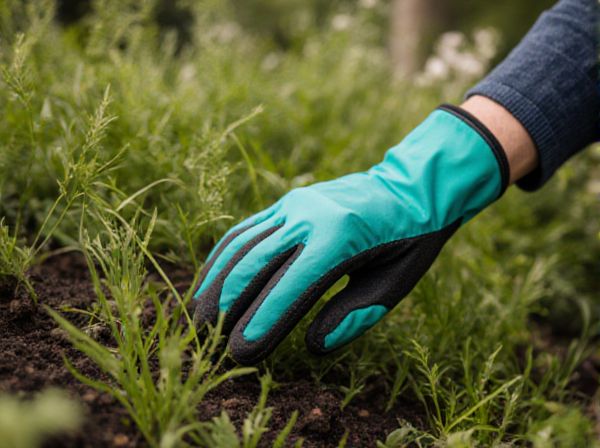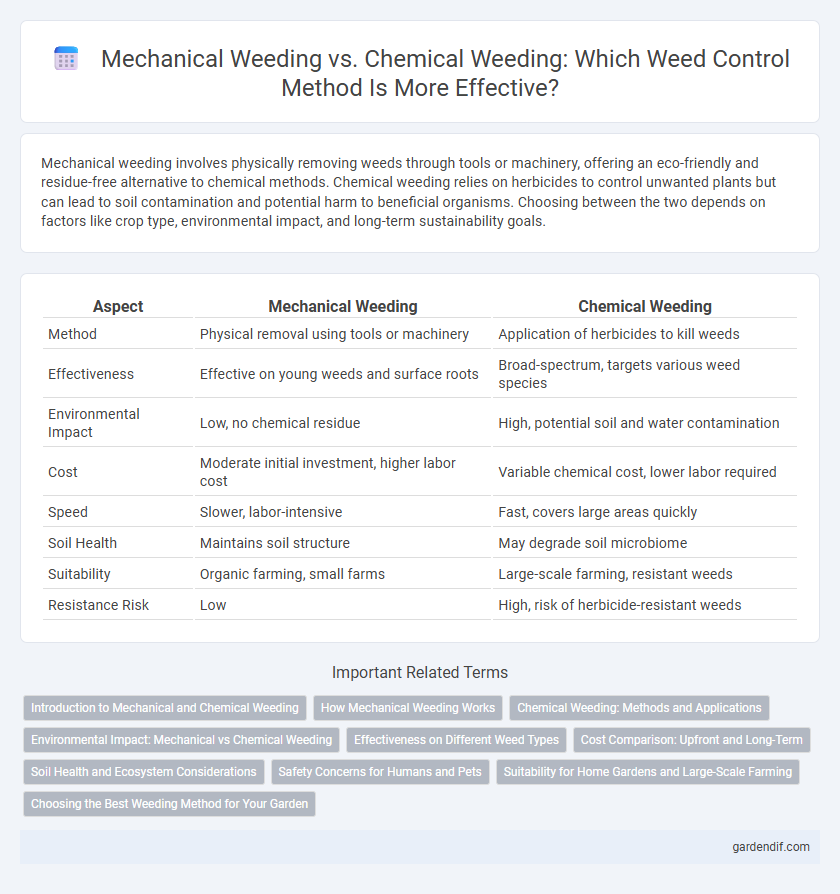
Mechanical weeding vs chemical weeding Illustration
Mechanical weeding involves physically removing weeds through tools or machinery, offering an eco-friendly and residue-free alternative to chemical methods. Chemical weeding relies on herbicides to control unwanted plants but can lead to soil contamination and potential harm to beneficial organisms. Choosing between the two depends on factors like crop type, environmental impact, and long-term sustainability goals.
Table of Comparison
| Aspect | Mechanical Weeding | Chemical Weeding |
|---|---|---|
| Method | Physical removal using tools or machinery | Application of herbicides to kill weeds |
| Effectiveness | Effective on young weeds and surface roots | Broad-spectrum, targets various weed species |
| Environmental Impact | Low, no chemical residue | High, potential soil and water contamination |
| Cost | Moderate initial investment, higher labor cost | Variable chemical cost, lower labor required |
| Speed | Slower, labor-intensive | Fast, covers large areas quickly |
| Soil Health | Maintains soil structure | May degrade soil microbiome |
| Suitability | Organic farming, small farms | Large-scale farming, resistant weeds |
| Resistance Risk | Low | High, risk of herbicide-resistant weeds |
Introduction to Mechanical and Chemical Weeding
Mechanical weeding involves physically removing weeds through tools or machinery such as hoes, cultivators, or rotary tillers, minimizing chemical use and soil disturbance. Chemical weeding utilizes herbicides to target and eliminate unwanted plants, offering efficiency in large-scale agricultural settings and controlling hard-to-reach weeds. Both methods address weed management challenges but differ in environmental impact, labor intensity, and cost considerations.
How Mechanical Weeding Works
Mechanical weeding involves the physical removal of weeds through methods such as hoeing, tilling, or using specialized machinery that disrupts weed growth by uprooting or cutting them. This technique targets weed roots and seedlings, reducing competition for nutrients and water without relying on herbicides. Mechanical weeding supports sustainable agriculture by minimizing chemical residues and environmental impact.
Chemical Weeding: Methods and Applications
Chemical weeding utilizes selective herbicides that target specific weed species while minimizing crop damage, offering efficient large-scale weed control. Common methods include pre-emergent application, which inhibits weed seed germination, and post-emergent spraying that eliminates actively growing weeds. This approach enables precise weed management in diverse agricultural systems, improving crop yield and reducing manual labor.
Environmental Impact: Mechanical vs Chemical Weeding
Mechanical weeding reduces soil contamination and preserves beneficial microorganisms, minimizing negative effects on biodiversity compared to chemical weeding. Chemical herbicides often lead to groundwater pollution and can contribute to the development of herbicide-resistant weed species. Implementing mechanical weeding supports sustainable agriculture by maintaining soil health and reducing chemical residues in ecosystems.
Effectiveness on Different Weed Types
Mechanical weeding is highly effective against large, established broadleaf weeds and grasses with shallow root systems by physically uprooting or cutting them, but it struggles with perennial weeds that have deep or extensive root networks. Chemical weeding, using selective herbicides, provides targeted control of specific weed species, including tough perennial and invasive plants, by disrupting their biological processes, ensuring long-term suppression. Integrating both methods can optimize weed management by addressing a broader spectrum of weed types and growth stages.
Cost Comparison: Upfront and Long-Term
Mechanical weeding involves higher initial costs due to machinery purchase and maintenance but reduces long-term expenses by minimizing chemical use and environmental impacts. Chemical weeding has lower upfront costs with easy application but often results in higher cumulative expenses from repeated herbicide purchases, resistance management, and potential soil health degradation. Cost efficiency ultimately depends on farm size, weed pressure, and sustainability goals, with mechanical methods favoring long-term savings and environmental compliance.
Soil Health and Ecosystem Considerations
Mechanical weeding preserves soil structure and microbial diversity by avoiding harmful chemical residues that disrupt nutrient cycles and beneficial organism populations. Chemical weeding often leads to soil degradation, reduced organic matter, and potential contamination of groundwater, negatively impacting overall ecosystem health. Selecting mechanical methods supports sustainable agriculture by maintaining soil integrity and promoting biodiversity within the agroecosystem.
Safety Concerns for Humans and Pets
Mechanical weeding poses fewer safety risks for humans and pets compared to chemical weeding, as it eliminates exposure to toxic herbicides that can cause respiratory issues, skin irritation, and long-term health problems. Chemical weed control, especially involving glyphosate or paraquat, has been linked to potential carcinogenic effects and neurotoxicity, raising significant concerns for household safety. Implementing mechanical methods like hoeing or using flame weeders reduces environmental contamination and accidental ingestion risks, making it a safer option for both gardeners and their animals.
Suitability for Home Gardens and Large-Scale Farming
Mechanical weeding offers a sustainable and eco-friendly solution ideal for home gardens, providing precise control without chemical residues that can harm beneficial insects and soil health. Chemical weeding is more suitable for large-scale farming due to its efficiency in covering extensive areas quickly, though it requires careful management to prevent environmental contamination and resistance build-up. Home gardeners benefit from mechanical techniques like hand-pulling and hoeing, while commercial farmers often rely on herbicides for cost-effective weed control over vast crop fields.
Choosing the Best Weeding Method for Your Garden
Mechanical weeding effectively removes weeds by physically uprooting them, making it ideal for small gardens or organic practices where chemical use is avoided. Chemical weeding offers fast and broad-spectrum weed control, suitable for larger areas but requires careful selection of herbicides to avoid damage to desired plants. Evaluating garden size, weed species, environmental impact, and safety concerns helps determine whether mechanical or chemical methods best suit your gardening needs.
Mechanical weeding vs chemical weeding Infographic

 gardendif.com
gardendif.com